UK Drive: Hyundai's Kona tries to keep its head up in an ever-crowded segment
The Hyundai Kona is another offering in the ever-flourishing compact crossover segment. Is it any good? Jack Evans finds out

What is it?
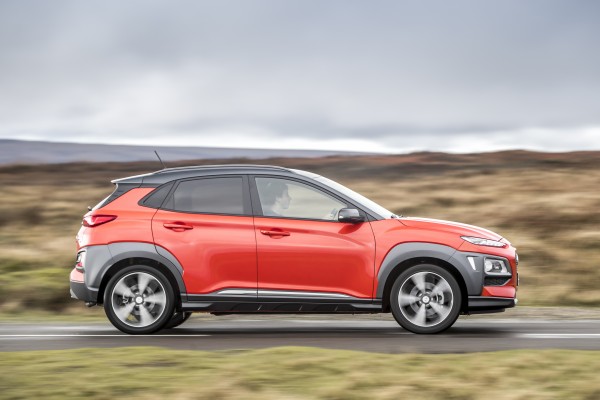
In keeping with other manufacturers, Hyundai has released its own compact SUV – the Kona. Going up against the likes of the Seat Arona and Kia Stonic, the Kona is aimed at younger families who want a little more space without sacrificing any ‘look at me’ styling touches. We’ve already tested it abroad, but this is the first time that we’ve been able to see how the South Korean manufacturer’s latest model deals with UK roads.
What’s new?
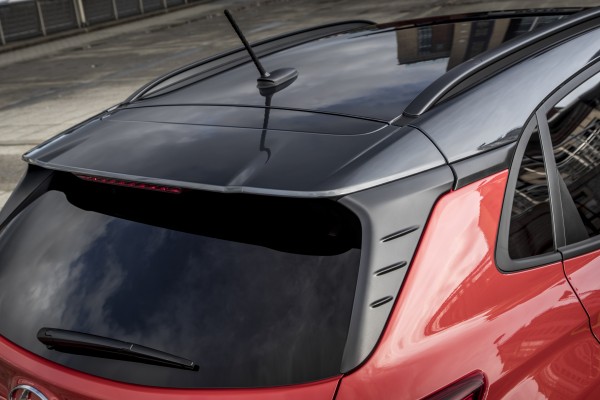
The Kona marks somewhat of a different direction for Hyundai. Whereas the manufacturer admits that for the most part people buy its cars due to an impression of value-for-money and reliability, it hopes that people will be opting for the Kona as a heart-led purchase. With funky styling and a variety of different colours, it certainly stands out from the rest of the Hyundai range. Available with both two- and four-wheel-drive, the Kona is designed for a more ‘active’ buyer, while a good amount of standard equipment – even on base specifications – should draw in more cost-conscious owners.
What’s under the bonnet?
The Kona is available from launch with either a 1.0-litre three-cylinder petrol engine or a 1.6-litre unit with all-wheel-drive and a seven-speed dual-clutch automatic transmission. Our test car was the former, powering just the front two wheels through a six-speed manual gearbox. Economy figures are good – Hyundai claims that the Kona will return 54.3mpg on a combined cycle and emit just 125g/km CO2. Performance is brisk enough for the segment, with the benchmark sprint to 60mph taking under 12 seconds.
What’s it like to drive?
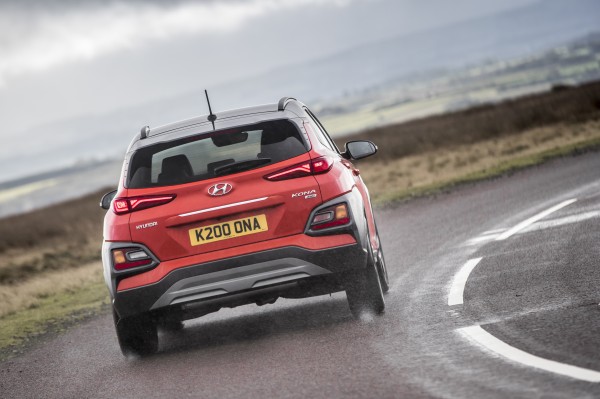
Ex-BMW M-Division head Albert Biermann is now overseeing all Hyundai car developments, and as such cars from each company are being infused with a certain degree of ‘sporty’ characteristics. This has already proved a huge hit with the Hyundai i30 N, offering hot hatch thrills for a far smaller price than competitors.
You can certainly feel that the Kona has been well set-up. The steering has plenty of weight to it, and you can accurately place the car just where you want it. However, the suspension seems just a touch too firm for UK roads, with the car crashing through larger potholes and being upset by smaller ones. The biggest thing you notice is the amount of road noise generated, however, with dual carriageways imparting a lot of sound into the cabin.
That said, the car’s six-speed gearbox is slick and easy to operate, while the 1.0-litre engine is punchy enough for the size of car – though can be left a little out of puff during steep inclines or when overtaking on the motorway.
How does it look?
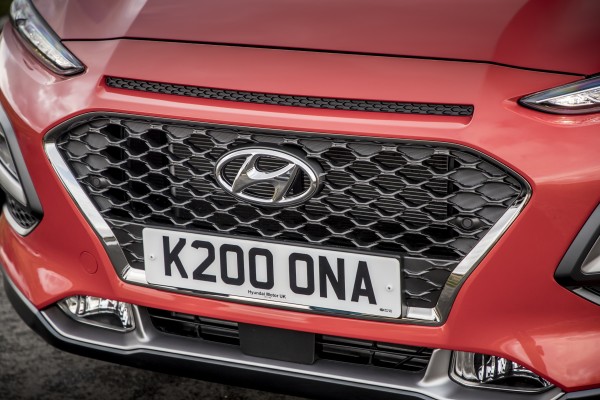
In our eyes at least, the Kona is a funky looking thing. There are a variety of different colours available, as well as contrasting roof shades. It certainly looks its best in brighter finishes such as ‘Tangerine’ orange, which helps the car stand out. However, even when finished in black it looks quite different to anything on the road at the moment.
What’s it like inside?
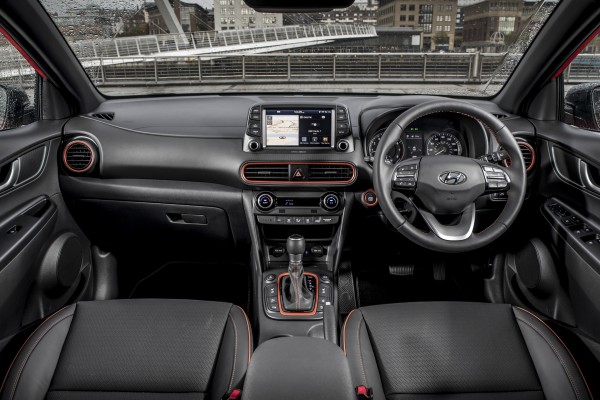
The interior of the Kona is, in general, a nice place to be. There are a few harder plastics to be found in the cabin, but it’s worth remembering that prices for the compact crossover start at £16,695. Our SE-spec car benefitted from a leather-wrapped steering wheel and electric driver’s seat lumbar support, which helped give the car a far more premium feel. There’s plenty of room for those sat up front too, with a large windscreen giving the cabin a spacious, airy feel.
Boot space is decent too, with 334 litres available with the rear seats in place, rising to 1,116 with them folded down. In comparison, the Citroen C3 Aircross is able to offer 410 litres rising to 520 litres.
What’s the spec like?
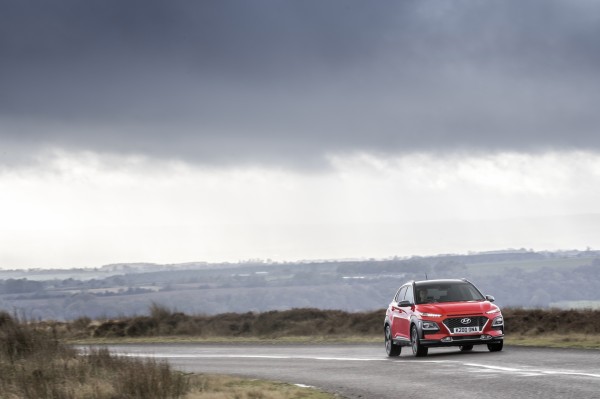
Standard equipment levels are good throughout the specifications, with even base S-trim cars receiving 16-inch alloy wheels, air-conditioning and automatic headlamps. In addition, DAB digital radio and Bluetooth connectivity is standard across the entire Kona range, regardless of trim level.
Our test car, finished in SE specification, gained larger 17-inch alloy wheels and roof rails, adding to the car’s visual presence. In addition, SE cars get rear parking sensors with a rear camera and a seven-inch colour touchscreen featuring Apple CarPlay and Android Auto for better smartphone integration.
Higher trim levels see features such as keyless entry and a premium sound system added to the Kona. In reality, most buyers will find the SE trim level more than adequate. A fine range of assistance systems are also included across the range, including lane keeping assist, downhill brake control and hill start assist control.
Verdict
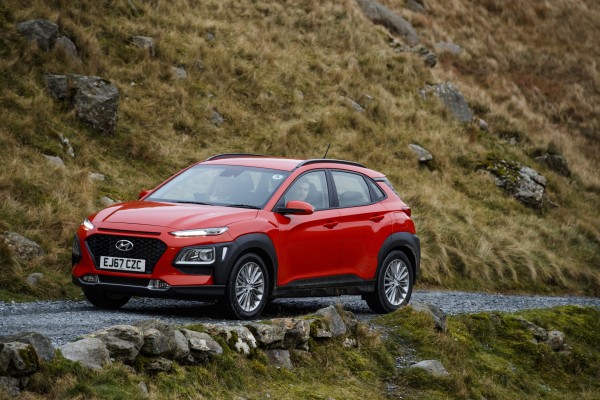
The Kona is a superbly well-rounded offering from Hyundai. Competitively priced and featuring plenty of standard equipment, it’s let down only by a relatively harsh ride and a noticeable amount of road noise. With so many alternatives hitting the market, the Kona certainly has a fight on its hands, but it goes in well-armed and capable of taking on more premium rivals.
Facts at a glance
Model: Hyundai Kona
Price as tested: £17,495
Engine: 1.0-litre turbocharged petrol
Power: 118bhp
Torque: 172Nm
Max speed: 113mph
0-60mph: 11.8
MPG (combined): 52.3
Emissions: 125g/km CO2





